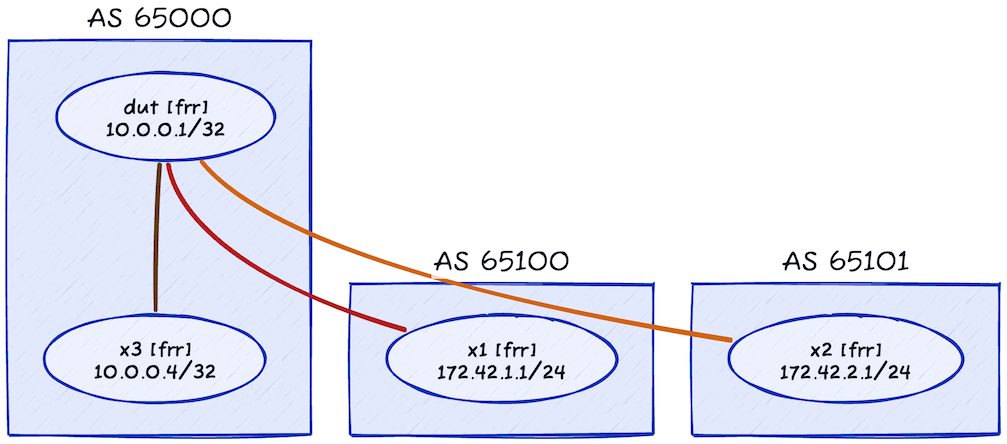iBGP Local-AS Route Propagation
In the previous blog post on this topic, I described the iBGP local-as functionality and explained why we MUST change the BGP next hop on the routes sent over the fake iBGP session (TL&DR: because we’re not running IGP across that link).
That blog post used a simple topology with three routers. Now let’s add a few more routers to the mix and see what happens.

The Device Under Test (DUT) in our lab has three BGP sessions:
- A real IBGP session with X3
- A real EBGP session with X1
- A fake IBGP (local-as IBGP) session with X2
We’ll use FRRouting as the DUT router; here’s the relevant configuration (including the next-hop-self option configured on the local-as IBGP session):
router bgp 65000
bgp router-id 10.0.0.1
no bgp default ipv4-unicast
bgp bestpath as-path multipath-relax
neighbor 10.0.0.4 remote-as 65000
neighbor 10.0.0.4 description x3 (IBGP)
neighbor 10.0.0.4 update-source lo
neighbor 10.1.0.2 remote-as 65100
neighbor 10.1.0.2 local-as 65002 no-prepend replace-as
neighbor 10.1.0.2 description x1 (EBGP)
neighbor 10.1.0.6 remote-as 65101
neighbor 10.1.0.6 local-as 65101 no-prepend replace-as
neighbor 10.1.0.6 description x2 (local-as IBGP)
!
address-family ipv4 unicast
network 10.0.0.1/32
network 172.42.42.0/24
neighbor 10.0.0.4 activate
neighbor 10.0.0.4 next-hop-self
neighbor 10.1.0.2 activate
no neighbor 10.1.0.2 send-community extended
neighbor 10.1.0.6 activate
neighbor 10.1.0.6 next-hop-self
Here’s how well route propagation works with our simplistic setup. The rows in the following table 1 are the routers advertising a prefix; the columns are the target routers.
| Source ⬇️ Target ➡️ | DUT | X1 (EBGP) | X2(Local-AS IBGP) | X3 (IBGP) |
|---|---|---|---|---|
| DUT | ✅ | ✅ | ✅ | ✅ |
| X1 | ✅ | ✅ | ✅ | ✅ |
| X2 | ✅ | ✅ | ✅ | ❌ |
| X3 | ✅ | ✅ | ❌ | ✅ |
- DUT can see all routes, as can X1 (no surprise there)
- X2 and X3 can see routes from DUT and X1 routes propagated by DUT
- DUT is not propagating routes between X2 and X3
What could possibly be wrong? Why wouldn’t DUT propagate IBGP routes received from X3 over another (albeit fake) IBGP session to X2?
Of course: the routes between the two IBGP sessions must be reflected. Trying to minimize the configuration changes, let’s configure X2 as a route-reflector client on DUT.
router bgp 65000
neighbor 10.1.0.6 description x2 (local-as IBGP)
!
address-family ipv4 unicast
neighbor 10.1.0.6 next-hop-self
neighbor 10.1.0.6 route-reflector-client
Did anything change? Here are the test results (limited to what’s visible on X2 and X3):
| Source ⬇️ Target ➡️ | X2(Local-AS IBGP) | X3 (IBGP) |
|---|---|---|
| DUT | ✅ | ✅ |
| X1 | ✅ | ✅ |
| X2 | ✅ | ❗️ |
| X3 | ❗️ | ✅ |
While the X2/X3 routes appear in the BGP tables on X3 and X2, they are not valid. Let’s look at the X3 prefix on X2:
x2# show ip bgp 172.42.3.0
BGP routing table entry for 172.42.3.0/24, version 0
Paths: (1 available, no best path)
Not advertised to any peer
Local, (Received from a RR-client)
10.0.0.4(dut) (inaccessible, import-check enabled) from dut(10.1.0.5) (10.0.0.4)
Origin IGP, metric 0, localpref 100, invalid, internal
Originator: 10.0.0.4, Cluster list: 10.0.0.1
Last update: Sat Aug 9 13:20:29 2025
We’re back to the next hop saga. Not only do we have to change the next hop on the EBGP routes sent to X2, we have to do it on all routes sent to X2 (including the reflected routes). Fortunately, numerous network operating systems support that nerd knob. Here’s the relevant FRRouting configuration:
router bgp 65000
neighbor 10.1.0.6 description x2 (local-as IBGP)
neighbor 10.0.0.4 description x3 (IBGP)
!
address-family ipv4 unicast
neighbor 10.0.0.4 next-hop-self force
neighbor 10.1.0.6 next-hop-self force
To recap. A router with at least one local-as IBGP session:
- MUST be a route-reflector for the local-as IBGP peer
- MUST set the next-hop to self on all IBGP and local-as IBGP sessions for EBGP and reflected IBGP routes.
- SHOULD NOT be used as a route reflector in its autonomous system (because it would mangle the next hops and redirect all the traffic to itself)
Furthermore, you MUST apply the same rules to the router on the other side of the local-as IBGP session2 (X2 in our topology).
